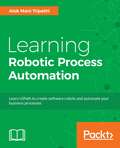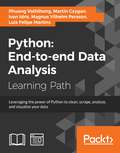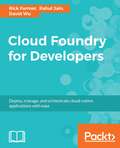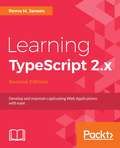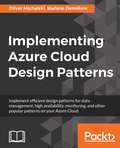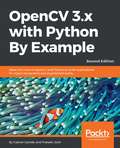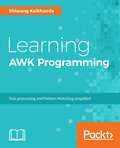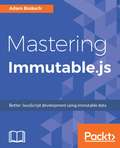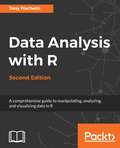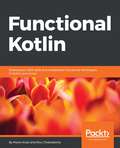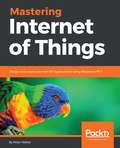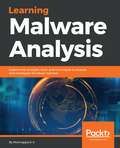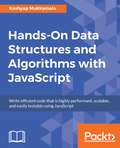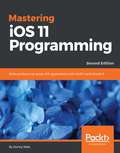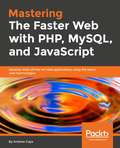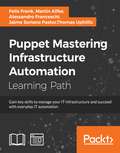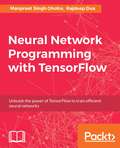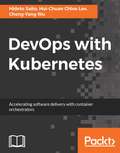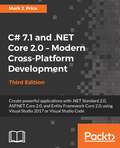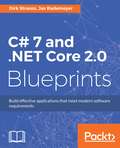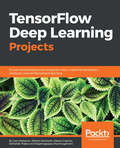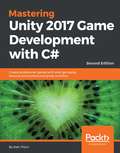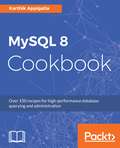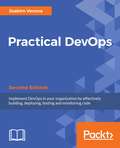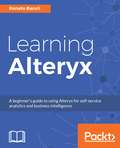- Table View
- List View
Learning Robotic Process Automation: Create Software robots and automate business processes with the leading RPA tool – UiPath
by Alok Mani TripathiDesign RPA solutions to perform a wide range of transactional tasks with minimal cost and maximum ROIKey FeaturesA beginner's guide to learn Robotic Process Automation and its impact on the modern worldDesign, test, and perform enterprise automation task with UiPathCreate Automation apps and deploy them to all the computers in your department.Book DescriptionRobotic Process Automation (RPA) enables automating business processes using software robots. Software robots interpret, trigger responses, and communicate with other systems just like humans do. Robotic processes and intelligent automation tools can help businesses improve the effectiveness of services faster and at a lower cost than current methods.This book is the perfect start to your automation journey, with a special focus on one of the most popular RPA tools: UiPath.Learning Robotic Process Automation takes you on a journey from understanding the basics of RPA to advanced implementation techniques. You will become oriented in the UiPath interface and learn about its workflow. Once you are familiar with the environment, we will get hands-on with automating different applications such as Excel, SAP, Windows and web applications, screen and web scraping, working with user events, as well as understanding exceptions and debugging. By the end of the book, you'll not only be able to build your first software bot, but also you'll wire it to perform various automation tasks with the help of best practices for bot deployment.What you will learnUnderstand Robotic Process Automation technologyLearn UiPath programming techniques to deploy robot configurationsExplore various data extraction techniquesLearn about integrations with various popular applications such as SAP and MS OfficeDebug a programmed robot including logging and exception handlingMaintain code version and source controlDeploy and control Bots with UiPath OrchestratorWho this book is forIf you would like to pursue a career in Robotic Process Automation or improve the efficiency of your businesses by automating common tasks, then this book is perfect for you. Prior programming knowledge of either Visual Basic or C# will be useful.
Python: End-to-end Data Analysis
by Ivan Idris Luiz Felipe Martins Magnus Vilhelm Persson Martin Czygan Phuong VothihongLeverage the power of Python to clean, scrape, analyze, and visualize your data About This Book • Clean, format, and explore your data using the popular Python libraries and get valuable insights from it • Analyze big data sets; create attractive visualizations; manipulate and process various data types using NumPy, SciPy, and matplotlib; and more • Packed with easy-to-follow examples to develop advanced computational skills for the analysis of complex data Who This Book Is For This course is for developers, analysts, and data scientists who want to learn data analysis from scratch. This course will provide you with a solid foundation from which to analyze data with varying complexity. A working knowledge of Python (and a strong interest in playing with your data) is recommended. What You Will Learn • Understand the importance of data analysis and master its processing steps • Get comfortable using Python and its associated data analysis libraries such as Pandas, NumPy, and SciPy • Clean and transform your data and apply advanced statistical analysis to create attractive visualizations • Analyze images and time series data • Mine text and analyze social networks • Perform web scraping and work with different databases, Hadoop, and Spark • Use statistical models to discover patterns in data • Detect similarities and differences in data with clustering • Work with Jupyter Notebook to produce publication-ready figures to be included in reports In Detail Data analysis is the process of applying logical and analytical reasoning to study each component of data present in the system. Python is a multi-domain, high-level, programming language that offers a range of tools and libraries suitable for all purposes, it has slowly evolved as one of the primary languages for data science. Have you ever imagined becoming an expert at effectively approaching data analysis problems, solving them, and extracting all of the available information from your data? If yes, look no further, this is the course you need! In this course, we will get you started with Python data analysis by introducing the basics of data analysis and supported Python libraries such as matplotlib, NumPy, and pandas. Create visualizations by choosing color maps, different shapes, sizes, and palettes then delve into statistical data analysis using distribution algorithms and correlations. You'll then find your way around different data and numerical problems, get to grips with Spark and HDFS, and set up migration scripts for web mining. You'll be able to quickly and accurately perform hands-on sorting, reduction, and subsequent analysis, and fully appreciate how data analysis methods can support business decision-making. Finally, you will delve into advanced techniques such as performing regression, quantifying cause and effect using Bayesian methods, and discovering how to use Python's tools for supervised machine learning. The course provides you with highly practical content explaining data analysis with Python, from the following Packt books: 1. Getting Started with Python Data Analysis. 2. Python Data Analysis Cookbook. 3. Mastering Python Data Analysis. By the end of this course, you will have all the knowledge you need to analyze your data with varying complexity levels, and turn it into actionable insights. Style and approach Learn Python data analysis using engaging examples and fun exercises, and with a gentle and friendly but comprehensive "learn-by-doing" approach. It offers you a useful way of analyzing the data that's specific to this course, but that can also be applied to any other data. This course is designed to be both a guide and a reference for moving beyond the basics of data analysis.
Cloud Foundry for Developers
by Rahul Jain Rick Farmer David WuDeploy and scale applications on Cloud Foundry About This Book • Gain hands-on experience using Cloud Foundry • Implement deployment, management and scaling of applications on Cloud Foundry • Learn best practices and troubleshooting tips for running applications on Cloud Foundry Who This Book Is For This book is aimed at developers, engineers and architects who want to learn key aspects of developing and running applications on the Cloud Foundry Platform. Prior knowledge Cloud Foundry is not necessary. What You Will Learn • Understand Cloud Foundry (CF) tools and concepts. • Understand the breadth of possibilities unleashed through a lightweight agile approach to building and deploying applications. • Design and deploy cloud native applications that run well on Cloud Foundry. • Learn Microservice design concepts and worker applications. • Customize service brokers to publish your services in the Cloud Foundry marketplace. • Using, managing and creating buildpacks for the Cloud Foundry Platform. • Troubleshoot applications on Cloud Foundry • Perform zero-downtime deployments using blue/green routes, A/B testing, and painless rollbacks to earlier versions of the application. In Detail Cloud Foundry is the open source platform to deploy, run, and scale applications. Cloud Foundry is growing rapidly and a leading product that provides PaaS (Platform as a Service) capabilities to enterprise, government, and organizations around the globe. Giants like Dell Technologies, GE, IBM, HP and the US government are using Cloud Foundry innovate faster in a rapidly changing world. Cloud Foundry is a developer's dream. Enabling them to create modern applications that can leverage the latest thinking, techniques and capabilities of the cloud, including: • DevOps • Application Virtualization • Infrastructure agnosticism • Orchestrated containers • Automation • Zero downtime upgrades • A/B deployment • Quickly scaling applications out or in This book takes readers on a journey where they will first learn the Cloud Foundry basics, including how to deploy and scale a simple application in seconds. Readers will build their knowledge of how to create highly scalable and resilient cloud-native applications and microservices running on Cloud Foundry. Readers will learn how to integrate their application with services provided by Cloud Foundry and with those external to Cloud Foundry. Readers will learn how to structure their Cloud Foundry environment with orgs and spaces. After that, we'll discuss aspects of continuous integration/continuous delivery (CI/CD), monitoring and logging. Readers will also learn how to enable health checks, troubleshoot and debug applications. By the end of this book, readers will have hands-on experience in performing various deployment and scaling tasks. Additionally, they will have an understanding of what it takes to migrate and develop applications for Cloud Foundry. Style and Approach A practitioner's guide to Cloud Foundry that covers the areas of application development, deployment and services.
Learning TypeScript 2.x: Develop and maintain captivating web applications with ease, 2nd Edition
by Remo H. JansenExploit the features of TypeScript to easily create your very own web applicationsKey Features Develop modular, scalable, maintainable, and adaptable web applications by taking advantage of TypeScript Walk through the fundamentals of TypeScript with the help of practical examples Enhance your web development skills using TypeScript 2.xBook DescriptionTypeScript is an open source and cross-platform statically typed superset of JavaScript that compiles to plain JavaScript and runs in any browser or host. This book is a step-by-step guide that will take you through the use and benefits of TypeScript with the help of practical examples. You will start off by understanding the basics as well as the new features of TypeScript 2.x. Then, you will learn how to work with functions and asynchronous programming APIs. You will continue by learning how to resolve runtime issues and how to implement TypeScript applications using the Object-oriented programming (OOP) and functional programming (FP) paradigms. Later, you will automate your development workflow with the help of tools such as Webpack. Towards the end of this book, you will delve into some real-world scenarios by implementing some full-stack TypeScript applications with Node.js, React and Angular as well as how to optimize and test them. Finally, you will be introduced to the internal APIs of the TypeScript compiler, and you will learn how to create custom code analysis tools.What you will learn Understand TypeScript in depth, including its runtime and advanced type system features Master the core principles of the object-oriented programming and functional programming paradigms with TypeScript Save time using automation tools such as Gulp, Webpack, ts-node, and npm scripts Develop robust, modular, scalable, maintainable, and adaptable applications with testing frameworks such as Mocha, Chai, and Sinon.JS Put your TypeScript skills to practice by developing full-stack web applications with Node.js, React and Angular Use the APIs of the TypeScript compiler to build custom code analysis toolWho this book is forIf you are a developer aiming to learn TypeScript to build attractive web applications, this book is for you. No prior knowledge of TypeScript is required. However, a basic understanding of JavaScript would be an added advantage.
Implementing Azure Cloud Design Patterns: Implement efficient design patterns for data management, high availability, monitoring and other popular patterns on your Azure Cloud
by Stefano Demiliani Oliver MichalskiA hands-on guide to mastering Azure cloud design patterns and best practices. Key Features Master architectural design patterns in Azure. Get hands-on with implementing design patterns. Implement best practices for improving efficiency and security Book Description A well designed cloud infrastructure covers factors such as consistency, maintenance, simplified administration and development, and reusability. Hence it is important to choose the right architectural pattern as it has a huge impact on the quality of cloud-hosted services. This book covers all Azure design patterns and functionalities to help you build your cloud infrastructure so it fits your system requirements. This book initially covers design patterns that are focused on factors such as availability and data management/monitoring. Then the focus shifts to complex design patterns such as multitasking, improving scalability, valet keys, and so on, with practical use cases. The book also supplies best practices to improve the security and performance of your cloud. By the end of this book, you will thoroughly be familiar with the different design and architectural patterns available with Windows Azure and capable of choosing the best pattern for your system. What you will learn Learn to organize Azure access Design the core areas of the Azure Execution Model Work with storage and data management Create a health endpoint monitoring pattern Automate early detection of anomalies Identify and secure Azure features Who this book is for This book is targeted at cloud architects and cloud solution providers who are looking for an extensive guide to implementing different patterns for the deployment and maintenance of services in Microsoft Azure. Prior experience with Azure is required as the book is completely focused on design patterns.
OpenCV 3.x with Python By Example: Make the most of OpenCV and Python to build applications for object recognition and augmented reality
by Gabriel Garrido Calvo Naren Yellavula Prateek JoshiLearn the techniques for object recognition, 3D reconstruction, stereo imaging, and other computer vision applications using examples on different functions of OpenCV. Key Features Learn how to apply complex visual effects to images with OpenCV 3.x and Python Extract features from an image and use them to develop advanced applications Build algorithms to help you understand image content and perform visual searches Get to grips with advanced techniques in OpenCV such as machine learning, artificial neural network, 3D reconstruction, and augmented reality Book Description Computer vision is found everywhere in modern technology. OpenCV for Python enables us to run computer vision algorithms in real time. With the advent of powerful machines, we have more processing power to work with. Using this technology, we can seamlessly integrate our computer vision applications into the cloud. Focusing on OpenCV 3.x and Python 3.6, this book will walk you through all the building blocks needed to build amazing computer vision applications with ease. We start off by manipulating images using simple filtering and geometric transformations. We then discuss affine and projective transformations and see how we can use them to apply cool advanced manipulations to your photos like resizing them while keeping the content intact or smoothly removing undesired elements. We will then cover techniques of object tracking, body part recognition, and object recognition using advanced techniques of machine learning such as artificial neural network. 3D reconstruction and augmented reality techniques are also included. The book covers popular OpenCV libraries with the help of examples. This book is a practical tutorial that covers various examples at different levels, teaching you about the different functions of OpenCV and their actual implementation. By the end of this book, you will have acquired the skills to use OpenCV and Python to develop real-world computer vision applications. What you will learn Detect shapes and edges from images and videos How to apply filters on images and videos Use different techniques to manipulate and improve images Extract and manipulate particular parts of images and videos Track objects or colors from videos Recognize specific object or faces from images and videos How to create Augmented Reality applications Apply artificial neural networks and machine learning to improve object recognitionWho this book is for This book is intended for Python developers who are new to OpenCV and want to develop computer vision applications with OpenCV and Python. This book is also useful for generic software developers who want to deploy computer vision applications on the cloud. It would be helpful to have some familiarity with basic mathematical concepts such as vectors, matrices, and so on.
Learning AWK Programming: A fast, and simple cutting-edge utility for text-processing on the Unix-like environment
by Shiwang KalkhandaText processing and pattern matching simplifiedKey Features-Master the fastest and most elegant big data munging language-Implement text processing and pattern matching using the advanced features of AWK and GAWK-Implement debugging and inter-process communication using GAWKBook DescriptionAWK is one of the most primitive and powerful utilities which exists in all Unix and Unix-like distributions. It is used as a command-line utility when performing a basic text-processing operation, and as programming language when dealing with complex text-processing and mining tasks. With this book, you will have the required expertise to practice advanced AWK programming in real-life examples. The book starts off with an introduction to AWK essentials. You will then be introduced to regular expressions, AWK variables and constants, arrays and AWK functions and more. The book then delves deeper into more complex tasks, such as printing formatted output in AWK, control flow statements, GNU's implementation of AWK covering the advanced features of GNU AWK, such as network communication, debugging, and inter-process communication in the GAWK programming language which is not easily possible with AWK. By the end of this book, the reader will have worked on the practical implementation of text processing and pattern matching using AWK to perform routine tasks.What you will learn-Create and use different expressions and control flow statements in AWK-Use Regular Expressions with AWK for effective text-processing -Use built-in and user-defined variables to write AWK programs-Use redirections in AWK programs and create structured reports-Handle non-decimal input, 2-way inter-process communication with Gawk-Create small scripts to reformat data to match patterns and process textsWho this book is forThis book is for developers or analysts who are inclined to learn how to do text processing and data extraction in a Unix-like environment. Basic understanding of Linux operating system and shell scripting will help you to get the most out of the book.
Mastering Immutable.js
by Adam BoduchThis book will be helpful to JavaScript developers from intermediate level and beyond who need to code reliably and efficiently using the Immutable.js JavaScript framework.
Data Analysis with R, Second Edition: A comprehensive guide to manipulating, analyzing, and visualizing data in R, 2nd Edition
by Anthony FischettiLearn, by example, the fundamentals of data analysis as well as several intermediate to advanced methods and techniques ranging from classification and regression to Bayesian methods and MCMC, which can be put to immediate use. Key FeaturesAnalyze your data using R – the most powerful statistical programming languageLearn how to implement applied statistics using practical use-casesUse popular R packages to work with unstructured and structured dataBook DescriptionFrequently the tool of choice for academics, R has spread deep into the private sector and can be found in the production pipelines at some of the most advanced and successful enterprises. The power and domain-specificity of R allows the user to express complex analytics easily, quickly, and succinctly. Starting with the basics of R and statistical reasoning, this book dives into advanced predictive analytics, showing how to apply those techniques to real-world data though with real-world examples.Packed with engaging problems and exercises, this book begins with a review of R and its syntax with packages like Rcpp, ggplot2, and dplyr. From there, get to grips with the fundamentals of applied statistics and build on this knowledge to perform sophisticated and powerful analytics. Solve the difficulties relating to performing data analysis in practice and find solutions to working with messy data, large data, communicating results, and facilitating reproducibility.This book is engineered to be an invaluable resource through many stages of anyone’s career as a data analyst.What you will learn Gain a thorough understanding of statistical reasoning and sampling theory Employ hypothesis testing to draw inferences from your data Learn Bayesian methods for estimating parameters Train regression, classification, and time series models Handle missing data gracefully using multiple imputation Identify and manage problematic data points Learn how to scale your analyses to larger data with Rcpp, data.table, dplyr, and parallelization Put best practices into effect to make your job easier and facilitate reproducibilityWho this book is forBudding data scientists and data analysts who are new to the concept of data analysis, or who want to build efficient analytical models in R will find this book to be useful. No prior exposure to data analysis is needed, although a fundamental understanding of the R programming language is required to get the best out of this book.
Functional Kotlin: Extend your OOP skills and implement Functional techniques in Kotlin and Arrow
by Rivu Chakraborty Mario AriasLearn how to apply Functional Programming with Kotlin to real-life projects with popular libraries like Arrow. Key Features ~Focus on the functional aspects of Kotlin and identify the advantages that functional programming brings to the table and the associated coding benefits,~Implement common functional programming design patterns and techniques. ~Learn to combine OOP and Reactive Programming with Functional Programming and how RxKotlin and funkTionale can help you implementing Functional Programming in Kotlin Book Description Functional programming makes your application faster, improves performance, and increases your productivity. Kotlin supports many of the popular and advanced functional features of functional languages. This book will cover the A-Z of functional programming in Kotlin. This book bridges the language gap for Kotlin developers by showing you how to create and consume functional constructs in Kotlin. We also bridge the domain gap by showing how functional constructs can be applied in business scenarios. We’ll take you through lambdas, pattern matching, immutability, and help you develop a deep understanding of the concepts and practices of functional programming. If you want learn to address problems using Recursion, Koltin has support for it as well. You’ll also learn how to use the funKtionale library to perform currying and lazy programming and more. Finally, you’ll learn functional design patterns and techniques that will make you a better programmer.By the end of the book, you will be more confident in your functional programming skills and will be able to apply them while programming in Kotlin. What you will learn Learn the Concepts of Functional Programming with Kotlin Discover the Coroutines in Kotlin Uncover Using funkTionale plugin Learn Monads, Functiors and Applicatives Combine Functional Programming with OOP and Reactive Programming Uncover Using Monads with funkTionale Discover Stream ProcessingWho this book is for Kotlin developers who have no functional programming experience, will benefit from this book.
Mastering Internet of Things: Design and create your own IoT applications using Raspberry Pi 3
by Peter WaherAugment your IoT skills with the help of engaging and enlightening tutorials designed for Raspberry Pi 3Key FeaturesDesign and implement state-of-the-art solutions for the Internet of ThingsBuild complex projects using motions detectors, controllers, sensors, and Raspberry Pi 3A hands-on guide that provides interoperable solutions for sensors, actuators, and controllersBook DescriptionThe Internet of Things (IoT) is the fastest growing technology market. Industries are embracing IoT technologies to improve operational expenses, product life, and people's well-being. Mastering Internet of Things starts by presenting IoT fundamentals and the smart city. You will learn the important technologies and protocols that are used for the Internet of Things, their features, corresponding security implications, and practical examples on how to use them. This book focuses on creating applications and services for the Internet of Things. Further, you will learn to create applications and services for the Internet of Things. You will be discover various interesting projects and understand how to publish sensor data, control devices, and react to asynchronous events using the XMPP protocol. The book also introduces chat, to interact with your devices. You will learn how to automate your tasks by using Internet of Things Service Platforms as the base for an application. You will understand the subject of privacy, requirements they should be familiar with, and how to avoid violating any of the important new regulations being introduced.At the end of the book, you will have mastered creating open, interoperable and secure networks of things, protecting the privacy and integrity of your users and their information.What you will learnCreate your own project, run and debug itMaster different communication patterns using the MQTT, HTTP, CoAP, LWM2M and XMPP protocolsBuild trust-based as hoc networks for open, secure and interoperable communication Explore the IoT Service PlatformManage the entire product life cycle of devicesUnderstand and set up the security and privacy features required for your systemMaster interoperability, and how it is solved in the realms of HTTP,CoAP, LWM2M and XMPPWho this book is forIf you're a developer or electronic engineer and are curious about the Internet of Things, this is the book for you. With only a rudimentary understanding of electronics and Raspberry Pi 3, and some programming experience using managed code, such as C# or Java, you will be taught to develop state-of-the-art solutions for the Internet of Things.
Learning Malware Analysis: Explore the concepts, tools, and techniques to analyze and investigate Windows malware
by Monnappa K AUnderstand malware analysis and its practical implementationKey FeaturesExplore the key concepts of malware analysis and memory forensics using real-world examplesLearn the art of detecting, analyzing, and investigating malware threatsUnderstand adversary tactics and techniquesBook DescriptionMalware analysis and memory forensics are powerful analysis and investigation techniques used in reverse engineering, digital forensics, and incident response. With adversaries becoming sophisticated and carrying out advanced malware attacks on critical infrastructures, data centers, and private and public organizations, detecting, responding to, and investigating such intrusions is critical to information security professionals. Malware analysis and memory forensics have become must-have skills to fight advanced malware, targeted attacks, and security breaches.This book teaches you the concepts, techniques, and tools to understand the behavior and characteristics of malware through malware analysis. It also teaches you techniques to investigate and hunt malware using memory forensics. This book introduces you to the basics of malware analysis, and then gradually progresses into the more advanced concepts of code analysis and memory forensics. It uses real-world malware samples, infected memory images, and visual diagrams to help you gain a better understanding of the subject and to equip you with the skills required to analyze, investigate, and respond to malware-related incidents.What you will learnCreate a safe and isolated lab environment for malware analysisExtract the metadata associated with malwareDetermine malware's interaction with the systemPerform code analysis using IDA Pro and x64dbgReverse-engineer various malware functionalitiesReverse engineer and decode common encoding/encryption algorithmsPerform different code injection and hooking techniquesInvestigate and hunt malware using memory forensicsWho this book is forThis book is for incident responders, cyber-security investigators, system administrators, malware analyst, forensic practitioners, student, or curious security professionals interested in learning malware analysis and memory forensics. Knowledge of programming languages such as C and Python is helpful but is not mandatory. If you have written few lines of code and have a basic understanding of programming concepts, you’ll be able to get most out of this book.
Hands-On Data Structures and Algorithms with JavaScript: Write efficient code that is highly performant, scalable, and easily testable using JavaScript
by Kashyap MukkamalaIncrease your productivity by implementing complex data structures and algorithms using JavaScript Key Features A step by step guide, which will provide you with a thorough discussion on the analysis and design of fundamental JavaScript data structures Get a better understanding of advanced concepts such as space and time complexity to optimize your code Focus more on solving the business problem and less on the technical challenges involved Book Description Data structures and algorithms are the fundamental building blocks of computer programming. They are critical to any problem, provide a complete solution, and act like reusable code. Using appropriate data structures and having a good understanding of algorithm analysis are key in JavaScript to solving crises and ensuring your application is less prone to errors. Do you want to build applications that are high-performing and fast? Are you looking for complete solutions to implement complex data structures and algorithms in a practical way? If either of these questions rings a bell, then this book is for you! You'll start by building stacks and understanding performance and memory implications. You will learn how to pick the right type of queue for the application. You will then use sets, maps, trees, and graphs to simplify complex applications. You will learn to implement different types of sorting algorithm before gradually calculating and analyzing space and time complexity. Finally, you'll increase the performance of your application using micro optimizations and memory management. By the end of the book you will have gained the skills and expertise necessary to create and employ various data structures in a way that is demanded by your project or use case. What you will learn Build custom Back buttons embedded within your application Build part of a basic JavaScript syntax parser and evaluator for an online IDE Build a custom activity user tracker for your application Generate accurate recommendations for credit card approval using Decision Trees Simplify complex problems using a graphs Increase the performance of an application using micro-optimizations Who this book is for If you are a JavaScript developer looking for practical examples to implement data structures and algorithms in your web applications, then this book is for you. Familiarity with data structures and algorithms will be helpful to get the most out of this book.
Mastering iOS 11 Programming - Second Edition
by Donny WalsTransition to a Professional iOS developer with the most in-depth and advanced level guide on Swift 4 and Xcode 9 About This Book • Filled with practical examples, this comprehensive guide explores all aspects of iOS Development. • Learn powerful techniques and industry`s best practices to become pro iOS Developer. • Unlock the full potential of iOS 11 programming with Swift 4 to build rich and powerful applications • Gain detailed insights into core iOS Programming concepts such as Extensions, Performance, Animations, CoreData and lot more with examples • Extend your iOS apps to new level with ARKit and CoreML Who This Book Is For This book is for developers who have some experience with iOS programming, but want to take their skills to next level by unlocking the full potential of latest version of iOS with Swift to build great applications. What You Will Learn • Build a professional iOS application from scratch • Create adaptive, complex views with Auto-Layout • Writing flexible and reusable code with Protocol Oriented programming • Ensure code quality by using proper tests. • Measure and improve performance with the Instruments app • Integrate with iOS on a deep level with several App Extensions • Implement AI, Machine Learning, Augmented Reality and more iOS 11 sweetness In Detail With good pay for iOS developers, a mature development environment, and Apple users spending more money on the App store than Android users, becoming a professional iOS developer is a great move. The journey to master iOS development and the new features of iOS 11 is not straightforward, but this book will help you make that transition. Written for Swift 4 and following the latest Swift API design guidelines, you won't just learn how to program for iOS 11, you'll learn how to write great, readable, and maintainable Swift code that's in line with the industry's best-practices. The progression of this book reflects the real-world development flow. In the book, you will build real-world applications. You will find a mix of thorough background information and practical examples, so you'll know how to make use of a technique right away while you also get a great understanding of the how and why. By the end, you will be able to build iOS applications that harness advanced techniques and make the best use of the latest and greatest features available in iOS 11. Style and approach This book takes a no-frill approach and is very code-specific. The focus is on teaching advanced concepts through a series of small projects and standalone examples that help you gain expertise with various aspects of iOS application development.
Mastering The Faster Web with PHP, MySQL, and JavaScript: Develop state-of-the-art web applications using the latest web technologies
by Andrew CayaMake web applications run faster by using advanced PHP, SQL and JavaScript techniquesKey FeaturesUse a customized PHP stack to create efficient data-driven web applicationsEnsure seamless implementation of a JavaScript & HTML 5 CSS based frontend and PHP based backend. Learn about problem identification, best strategies, and UI design patterns as well to build a clean, fast web applicationBook DescriptionThis book will get you started with the latest benchmarking, profiling and monitoring tools for PHP, MySQL and JavaScript using Docker-based technologies. From optimizing PHP 7 code to learning asynchronous programming, from implementing Modern SQL solutions to discovering Functional JavaScript techniques, this book covers all the latest developments in Faster Web technologies. You will not only learn to determine the best optimization strategies, but also how to implement them.Along the way, you will learn how to profile your PHP scripts with Blackfire.io, monitor your Web applications, measure database performance, optimize SQL queries, explore Functional JavaScript, boost Web server performance in general and optimize applications when there is nothing left to optimize by going beyond performance.After reading this book, you will know how to boost the performance of any Web application and make it part of what has come to be known as the Faster Web.What you will learnInstall, confgure, and use profling and benchmarking testing toolsUnderstand how to recognize optimizable data structures and functions to effectively optimize a PHP7 applicationDiagnose bad SQL query performance and discover ways to optimize itGrasp modern SQL techniques to optimize complex SQL queriesIdentify and simplify overly complex JavaScript codeExplore and implement UI design principles that effectively enhance the performanceCombine web technologies to boost web server performanceWho this book is forThe audience for this book would be PHP developers who have some basic knowledge of PHP programming and Web technologies. JavaScript programming knowledge is not necessary.
Puppet: Mastering Infrastructure Automation
by Alessandro Franceschi Felix Frank Jaime Soriano Pastor Martin Alfke Thomas UphillisStart pulling the strings of your IT infrastructure effectively with Puppet – learn how to configure, customize and manage your systems more intelligently in an enterprise deployment. About This Book • Step-by-step instructions to jump start your Puppet deployment and automate your IT configurations • Design, implement, and deploy Puppet in your infrastructure and tackle everyday IT infrastructure challenges • Gain expert understanding of Puppet's latest and most advanced features Who This Book Is For If you're an experienced IT professional and a new Puppet user, this course will provide you with all you need to know to go from installation to advanced automation. What You Will Learn • Write and employ individual Puppet manifests • Understand how Puppet implements system abstraction • Use Puppet to manage network, cloud, and virtualization devices • Manage and test the Puppet code workflow • Tweak, hack, and adapt the Puppet extension points • Use exported resources to orchestrate change between machines • Debug a puppetserver using Java techniques In Detail Puppet is a configuration management tool that allows you to automate all your IT configurations, giving you control. It was written for and by system administrators to manage large numbers of systems efficiently and prevent configuration drifts. Puppet gives you control of what you do to each node, when you do it, and how you do it.This Learning Path will take you from the basics of Puppet to extending it and then mastering it. We will start off with a primer on Puppet, its installation and get a sneak peek under its hood. We will then move on to designing and deploying your Puppet architecture, learning best practices for writing reusable and maintainable code, and executing, testing, and deploying Puppet across your systems. Finally, we will deal with problems of scale and exceptions in your code, automate workflows, and support multiple developers working simultaneously.This course is based on the following books: 1. Puppet 4 Essentials - Second Edition 2. Extending Puppet - Second Edition 3. Mastering Puppet - Second Edition Style and approach This learning path follows a practical approach, starting from the basic commands to advanced aspects. Through a series of examples you will learn the most important skills essential to manage your IT infrastructure effectively.
Neural Network Programming with TensorFlow: Unleash the power of TensorFlow to train efficient neural networks
by Rajdeep Dua Manpreet Singh GhotraNeural Networks and their implementation decoded with TensorFlow About This Book • Develop a strong background in neural network programming from scratch, using the popular Tensorflow library. • Use Tensorflow to implement different kinds of neural networks – from simple feedforward neural networks to multilayered perceptrons, CNNs, RNNs and more. • A highly practical guide including real-world datasets and use-cases to simplify your understanding of neural networks and their implementation. Who This Book Is For This book is meant for developers with a statistical background who want to work with neural networks. Though we will be using TensorFlow as the underlying library for neural networks, book can be used as a generic resource to bridge the gap between the math and the implementation of deep learning. If you have some understanding of Tensorflow and Python and want to learn what happens at a level lower than the plain API syntax, this book is for you. What You Will Learn • Learn Linear Algebra and mathematics behind neural network. • Dive deep into Neural networks from the basic to advanced concepts like CNN, RNN Deep Belief Networks, Deep Feedforward Networks. • Explore Optimization techniques for solving problems like Local minima, Global minima, Saddle points • Learn through real world examples like Sentiment Analysis. • Train different types of generative models and explore autoencoders. • Explore TensorFlow as an example of deep learning implementation. In Detail If you're aware of the buzz surrounding the terms such as "machine learning," "artificial intelligence," or "deep learning," you might know what neural networks are. Ever wondered how they help in solving complex computational problem efficiently, or how to train efficient neural networks? This book will teach you just that. You will start by getting a quick overview of the popular TensorFlow library and how it is used to train different neural networks. You will get a thorough understanding of the fundamentals and basic math for neural networks and why TensorFlow is a popular choice Then, you will proceed to implement a simple feed forward neural network. Next you will master optimization techniques and algorithms for neural networks using TensorFlow. Further, you will learn to implement some more complex types of neural networks such as convolutional neural networks, recurrent neural networks, and Deep Belief Networks. In the course of the book, you will be working on real-world datasets to get a hands-on understanding of neural network programming. You will also get to train generative models and will learn the applications of autoencoders. By the end of this book, you will have a fair understanding of how you can leverage the power of TensorFlow to train neural networks of varying complexities, without any hassle. While you are learning about various neural network implementations you will learn the underlying mathematics and linear algebra and how they map to the appropriate TensorFlow constructs. Style and Approach This book is designed to give you just the right number of concepts to back up the examples. With real-world use cases and problems solved, this book is a handy guide for you. Each concept is backed by a generic and real-world problem, followed by a variation, making you independent and able to solve any problem with neural networks. All of the content is demystified by a simple and straightforward approach.
DevOps with Kubernetes
by Hui-Chuan Chloe Lee Hideto Saito Cheng-Yang WuLearn to implement DevOps using Docker & Kubernetes. About This Book • Learning DevOps, container, and Kubernetes within one book. • Leverage Kubernetes as a platform to deploy, scale, and run containers efficiently. • A practical guide towards container management and orchestration Who This Book Is For This book is targeted for anyone, who wants to learn containerization and clustering in a practical way using Kubernetes. No prerequisite skills required, however, essential DevOps skill and public/private Cloud knowledge will accelerate the reading speed. If you're advanced readers, you can also get a deeper understanding of all the tools and technique described in the book. What You Will Learn • Learn fundamental and advanced DevOps skills and tools • Get a comprehensive understanding for container • Learn how to move your application to container world • Learn how to manipulate your application by Kubernetes • Learn how to work with Kubernetes in popular public cloud • Improve time to market with Kubernetes and Continuous Delivery • Learn how to monitor, log, and troubleshoot your application with Kubernetes In Detail Containerization is said to be the best way to implement DevOps. Google developed Kubernetes, which orchestrates containers efficiently and is considered the frontrunner in container orchestration. Kubernetes is an orchestrator that creates and manages your containers on clusters of servers. This book will guide you from simply deploying a container to administrate a Kubernetes cluster, and then you will learn how to do monitoring, logging, and continuous deployment in DevOps. The initial stages of the book will introduce the fundamental DevOps and the concept of containers. It will move on to how to containerize applications and deploy them into. The book will then introduce networks in Kubernetes. We then move on to advanced DevOps skills such as monitoring, logging, and continuous deployment in Kubernetes. It will proceed to introduce permission control for Kubernetes resources via attribute-based access control and role-based access control. The final stage of the book will cover deploying and managing your container clusters on the popular public cloud Amazon Web Services and Google Cloud Platform. At the end of the book, other orchestration frameworks, such as Docker Swarm mode, Amazon ECS, and Apache Mesos will be discussed. Style and approach Readers will be taken through fundamental DevOps skills and Kubernetes concept and administration with detailed examples. It introduces comprehensive DevOps topics, including microservices, automation tools, containers, monitoring, logging, continuous delivery, and popular public cloud environments. At each step readers will learn how to leverage Kubernetes in their everyday lives and transform their original delivery pipeline for fast and efficient delivery.
C# 7.1 and .NET Core 2.0 – Modern Cross-Platform Development , Third Edition
by Mark J. PriceC# 7.1 and .NET Core 2.0 – Modern Cross-Platform Development is a practical guide to creating powerful cross-platform applications with C# 7.1 and .NET Core 2.0. This cutting-edge book covers the very latest major release, providing you with all of the knowledge a modern C# developer needs.
C# 7 and .NET Core 2.0 Blueprints: Build effective applications that meet modern software requirements
by Dirk Strauss Jas RademeyerLeverage the features of C# 7 and .NET core 2.0 to build real-world .NET core applicationsKey Features See how to incorporate Entity Framework Core to build ASP .NET core MVC application Get hands-on SignalR and NuGet packages Work with Reactive Extensions (Rx.Net) using the elasticsearch tool Get hands-on with .NET Core MVC, Middleware, Controllers, Views, Layouts, Routing, and authentication Implement Azure Service Fabric and Microservices and AWS, S3,Serverless computing Work on .NET Core cross-platform functionality Run a .NET Core MVC application with Docker compose Easy-to-follow real-world projects that get you up and running with the new features of C# 7 and .NET Core 2.0 The practical applications will assist you with concepts such as Entity Framework Core, serverless computing, microservices, and more in .NET Core 2.0 Explore the workings of Rx.Net and build cross-platform mobile applications using XamarinBook DescriptionNET Core is a general purpose, modular, cross-platform, and open source implementation of .NET. With the latest release of .NET Core, many more APIs are expected to show up, which will make APIs consistent across .Net Framework, .NET Core, and Xamarin. This step-by-step guide will teach you the essential .NET Core and C# concepts with the help of real-world projects.The book starts with a brief introduction to the latest features of C# 7 and .NET Core 2.0 before moving on to explain how C# 7 can be implemented using the object-oriented paradigm. You'll learn to work with relational data using Entity Framework and see how to use ASP.NET Core practically. This book will show you how .NET Core allows the creations of cross-platform applications.You'll also learn about SignalR to add real-time functionality to your application. Then you will see how to use MongoDB and how to implement MongoDB into your applications. You'll learn about serverless computing and OAuth concepts, along with running ASP.NET Core applications with Docker Compose.This project-based guide uses practical applications to demonstrate these concepts. By the end of the book, you'll be profcient in developing applications using .NET Core 2.0What you will learnHow to incorporate Entity Framework Core to build ASP .NET Core MVC applicationsGet hands-on experience with SignalR, and NuGet packagesWorking with MongoDB in your ASP.NET Core MVC applicationGet hands-on experience with .NET Core MVC, Middleware, Controllers, Views, Layouts, Routing, and OAuthImplementing Azure Functions and learn what Serverless computing meansSee how .NET Core enables cross-platform applications that run on Windows, macOS and LinuxRunning a .NET Core MVC application with Docker ComposeWho this book is forThis book is for .NET developers who would like to master and implement C# 7 and .NET Core 2.0 with practical projects. Basic knowledge of .NET Core and C# is assumed.
TensorFlow Deep Learning Projects: 10 real-world projects on computer vision, machine translation, chatbots, and reinforcement learning
by Alberto Boschetti Luca Massaron Alexey Grigorev Rajalingappaa Shanmugamani Abhishek ThakurLeverage the power of Tensorflow to design deep learning systems for a variety of real-world scenariosKey FeaturesBuild efficient deep learning pipelines using the popular Tensorflow frameworkTrain neural networks such as ConvNets, generative models, and LSTMsIncludes projects related to Computer Vision, stock prediction, chatbots and moreBook DescriptionTensorFlow is one of the most popular frameworks used for machine learning and, more recently, deep learning. It provides a fast and efficient framework for training different kinds of deep learning models, with very high accuracy. This book is your guide to master deep learning with TensorFlow with the help of 10 real-world projects.TensorFlow Deep Learning Projects starts with setting up the right TensorFlow environment for deep learning. Learn to train different types of deep learning models using TensorFlow, including Convolutional Neural Networks, Recurrent Neural Networks, LSTMs, and Generative Adversarial Networks. While doing so, you will build end-to-end deep learning solutions to tackle different real-world problems in image processing, recommendation systems, stock prediction, and building chatbots, to name a few. You will also develop systems that perform machine translation, and use reinforcement learning techniques to play games.By the end of this book, you will have mastered all the concepts of deep learning and their implementation with TensorFlow, and will be able to build and train your own deep learning models with TensorFlow confidently.What you will learnSet up the TensorFlow environment for deep learningConstruct your own ConvNets for effective image processingUse LSTMs for image caption generationForecast stock prediction accurately with an LSTM architectureLearn what semantic matching is by detecting duplicate Quora questionsSet up an AWS instance with TensorFlow to train GANsTrain and set up a chatbot to understand and interpret human inputBuild an AI capable of playing a video game by itself –and win it!Who this book is forThis book is for data scientists, machine learning developers as well as deep learning practitioners, who want to build interesting deep learning projects that leverage the power of Tensorflow. Some understanding of machine learning and deep learning, and familiarity with the TensorFlow framework is all you need to get started with this book.
Mastering Unity 2017 Game Development with C# - Second Edition
by Alan ThornMaster realistic animations and graphics, particle systems, game AI and physics, sprites and VR development with Unity 2017 About This Book • Create professional grade games with realistic animation and graphics, particle systems and game physics with Unity 2017 • Unleash the power of C# scripting to create intelligent game AI and professional grade game workflows. • Create immersive VR games using the latest Unity 2017 VR SDK. Who This Book Is For If you are a Unity developer who now wants to develop and deploy interesting games by leveraging the new features of Unity 2017, then this is the book for you. Basic knowledge of C# programming is assumed. What You Will Learn • Explore hands-on tasks and real-world scenarios to make a Unity horror adventure game • Create enemy characters that act intelligently and make reasoned decisions • Use data files to save and restore game data in a way that is platform-agnostic • Get started with VR development • Use navigation meshes, occlusion culling, and Profiler tools • Work confidently with GameObjects, rotations, and transformations • Understand specific gameplay features such as AI enemies, inventory systems, and level design In Detail Do you want to make the leap from being an everyday Unity developer to being a pro game developer? Then look no further! This book is your one-stop solution to creating mesmerizing games with lifelike features and amazing gameplay. This book focuses in some detail on a practical project with Unity, building a first-person game with many features. You'll delve into the architecture of a Unity game, creating expansive worlds, interesting render effects, and other features to make your games special. You will create individual game components, use efficient animation techniques, and implement collision and physics effectively. Specifically, we'll explore optimal techniques for importing game assets, such as meshes and textures; tips and tricks for effective level design; how to animate and script NPCs; how to configure and deploy to mobile devices; how to prepare for VR development; how to work with version control; and more. By the end of this book, you'll have developed sufficient competency in Unity development to produce fun games with confidence. Style and approach This book takes an easy-to-follow, step-by-step tutorial approach. You will create an advanced level Unity game with an emphasis on leveraging advanced Unity 2017 features while developing the game in its entirety.
MySQL 8 Cookbook: Over 150 recipes for high-performance database querying and administration
by Karthik Appigatla Kedar Mohaniraj VaijanapukarDesign and administer enterprise-grade MySQL 8 solutions Key Features Store, retrieve, and manipulate your data using the latest MySQL 8 features Practical recipes on effective administration in MySQL, with a focus on security, performance tuning, troubleshooting, and more Contains tips, tricks, and best practices for designing, developing, and administering your MySQL 8 database solution without any hassle Book Description MySQL is one of the most popular and widely used relational databases in the World today. The recently released MySQL 8 version promises to be better and more efficient than ever before. This book contains everything you need to know to be the go-to person in your organization when it comes to MySQL. Starting with a quick installation and configuration of your MySQL instance, the book quickly jumps into the querying aspects of MySQL. It shows you the newest improvements in MySQL 8 and gives you hands-on experience in managing high-transaction and real-time datasets. If you've already worked with MySQL before and are looking to migrate your application to MySQL 8, this book will also show you how to do that. The book also contains recipes on efficient MySQL administration, with tips on effective user management, data recovery, security, database monitoring, performance tuning, troubleshooting, and more. With quick solutions to common and not-so-common problems you might encounter while working with MySQL 8, the book contains practical tips and tricks to give you the edge over others in designing, developing, and administering your database effectively. What you will learn - Install and configure your MySQL 8 instance without any hassle - Get to grips with new features of MySQL 8 like CTE, Window functions and many more - Perform backup tasks, recover data and set up various replication topologies for your database - Maximize performance by using new features of MySQL 8 like descending indexes, controlling query optimizer and resource groups - Learn how to use general table space to suit the SaaS or multi-tenant applications - Analyze slow queries using performance schema, sys schema and third party tools - Manage and monitor your MySQL instance and implement efficient performance-tuning tasks Who this book is for If you are a MySQL developer or administrator looking for quick, handy solutions to solve the most common and not-so-common problems in MySQL, this book is for you. MySQL DBAs looking to get up-to-speed with the latest MySQL 8 development and administration features will also find this book very useful. Prior knowledge of Linux and RDBMS is desirable.
Practical DevOps, Second Edition: Implement DevOps in your organization by effectively building, deploying, testing, and monitoring code, 2nd Edition
by Joakim VeronaUnderstand the benefits of DevOps and continuous delivery and see how they support the agile software development processKey FeaturesLearn how DevOps can accelerate your entire software development life cycleImprove your organization's performance to ensure the smooth production of software and servicesGet hands-on experience in using efficient DevOps tools to better effectBook DescriptionDevOps is a practical field that focuses on delivering business value as efficiently as possible. DevOps encompasses all code workflows from testing environments to production environments. It stresses cooperation between different roles, and how they can work together more closely, as the roots of the word imply—Development and Operations.Practical DevOps begins with a quick refresher on DevOps and continuous delivery and quickly moves on to show you how DevOps affects software architectures. You'll create a sample enterprise Java application that you’'ll continue to work with through the remaining chapters. Following this, you will explore various code storage and build server options. You will then learn how to test your code with a few tools and deploy your test successfully. In addition to this, you will also see how to monitor code for any anomalies and make sure that it runs as expected. Finally, you will discover how to handle logs and keep track of the issues that affect different processes.By the end of the book, you will be familiar with all the tools needed to deploy, integrate, and deliver efficiently with DevOps.What you will learnUnderstand how all deployment systems fit together to form a larger systemSet up and familiarize yourself with all the tools you need to be efficient with DevOpsDesign an application suitable for continuous deployment systems with DevOps in mindStore and manage your code effectively using Git, Gerrit, Gitlab, and moreConfigure a job to build a sample CRUD applicationTest your code using automated regression testing with Jenkins SeleniumDeploy your code using tools such as Puppet, Ansible, Palletops, Chef, and VagrantWho this book is forIf you're a developer or system administrator looking to take on larger responsibilities and understand how the infrastructure that builds today's enterprises works, this is the book for you. This book will also help you greatly if you're an operations worker who would like to better support developers. You do not need any previous knowledge of DevOps to understand the concepts in this book.
Learning Alteryx: A beginner's guide to using Alteryx for self-service analytics and business intelligence
by Alok Khobragade Mayur Ravindra Narkhede Renato BarutiKey Features Experience the power of codeless analytics using Alteryx, a leading Business Intelligence tool Uncover hidden trends and valuable insights from your data across different sources and make accurate predictions Includes real-world examples to put your understanding of the features in Alteryx to practical use Book Description Alteryx, as a leading data blending and advanced data analytics platform, has taken self-service data analytics to the next level. Companies worldwide often find themselves struggling to prepare and blend massive datasets that are time-consuming for analysts. Alteryx solves these problems with a repeatable workflow designed to quickly clean, prepare, blend, and join your data in a seamless manner. This book will set you on a self-service data analytics journey that will help you create efficient workflows using Alteryx, without any coding involved. It will empower you and your organization to take well-informed decisions with the help of deeper business insights from the data.Starting with the fundamentals of using Alteryx such as data preparation and blending, you will delve into the more advanced concepts such as performing predictive analytics. You will also learn how to use Alteryx’s features to share the insights gained with the relevant decision makers. To ensure consistency, we will be using data from the Healthcare domain throughout this book. The knowledge you gain from this book will guide you to solve real-life problems related to Business Intelligence confidently. Whether you are a novice with Alteryx or an experienced data analyst keen to explore Alteryx’s self-service analytics features, this book will be the perfect companion for you. What you will learn Create efficient workflows with Alteryx to answer complex business questions Learn how to speed up the cleansing, data preparing, and shaping process Blend and join data into a single dataset for self-service analysis Write advanced expressions in Alteryx leading to an optimal workflow for efficient processing of huge data Develop high-quality, data-driven reports to improve consistency in reporting and analysis Explore the flexibility of macros by automating analytic processes Apply predictive analytics from spatial, demographic, and behavioral analysis and quickly publish, schedule Share your workflows and insights with relevant stakeholders
